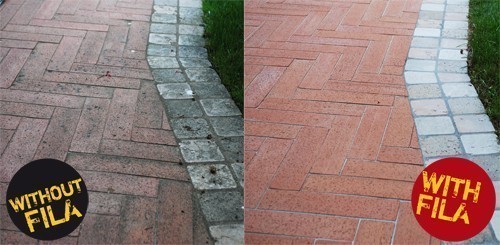If you want to keep your garden looking nice, you need to take care of your external surfaces and not only look after your plants. Heaps of dead leaves or flowers often build up on porches or garden paths, allowing natural dyes to seep through and leaving dark unsightly marks.
How can you get around this problem? FILA is here to help with FILAPS87 and HYDROREP ECO: two products which help you to clean and protect your external surfaces. Discover how to use them!
How can you remove stains from external surfaces?
With FILAPS87, FILA’s de-greasing, wax-removing detergent, you will be able to thoroughly clean any surfaces, especially external ones which are more prone to dirt and grime.
Let us take you through it step by step:
Degreasing the surface or flooring with FILAPS87 is very straightforward:
- dilute the product in water (1:5) and apply to the surface.
- Leave it to act for about 4-5 minutes
- now use a brush (or floor scrubber) and then wipe away the dirt with a cloth and rinse well.
How can you stop algae and mould from coming back?
After having properly cleaned and dried the surface for treatment, apply HYDROREP ECO which is a water-repellent product by FILA with a natural effect. It creates a barrier which prevents algae and mould from growing, whilst allowing the material to retain its own essential breathability.
Let’s go through the treatment together:
- Apply a coat of undiluted product to the clean dry wall, impregnating the material thoroughly with a brush or airless pump. If your wall is made from terracotta, exposed brickwork, stone or plaster, one litre of product will be sufficient to cover a surface area of 10-20 sq.m., whilst for concrete one litre of product will cover 8-10 sq.m. of wall.
- Before the product dries, make sure is no residue. If there is any left, dab it with a clean cloth to remove.
- After only 4 hours, your surface will be dry and protected.
Tested for sheer effectiveness!
The effectiveness of HYDROREP ECO has been proven by laboratory tests in keeping with UNI EN ISO 846:1999 standards. These tests have shown how treatment with gives the material greater resilience against aggressive micro-organisms as compared to untreated materials which succumb to attacks by fungus and micro-organisations and undergo damage to the surface.

